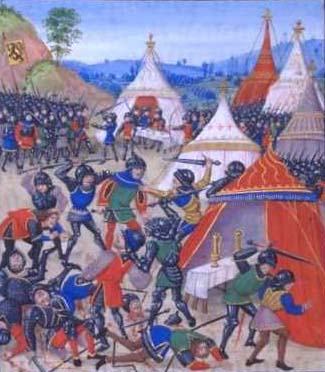There is a joy to camping with
the SCA that comes from immersing oneself
into the Medieval persona of one's own creation. Where else can
one leave the mundane world behind and spend a few days camping
with friends, just as they did in the Dark Ages. . .
. . . Only, . . well, . . did anyone at all actually "go
camping" back then?
We know they had tents, sure; but who used
them? As historical reenactors, what is it exactly that we are
trying to reenact? Part of the answer is that we are just trying
to all get together, and don't happen to have a proper Medieval
city available with its homes, halls, laundry cellars, food markets,
and defensible walls. What each of us does to make the best of
that shortcoming is the rest of the answer.
A popular choice is the "What tent?"
approach. Once up and out of it, one's own tent becomes as much
a non-issue as would the home of any period Lord or Lady during
a day of errands and a night of adventure. Out of site is out
of mind.
This goes hand-in-hand with the "What do you mean; a tent?" approach. These folk see wattle and daub or hewn
stone where others might see ripstop nylon; the tent represents
a real home, and the campground a real town. Their ultimate expression
is found in the temporary buildings and trailerable "wagons"
and "ships" which make the dream easier for others
to share!
The next crowd eschews all such guile, and
straightforward says; "This
is my tent." Here are found the
Crusaders and Landsknecht in their canvas pavilions, the Roman
soldiers in their austere leather barracks, the Mongols in their
felt yurts, the nomads, and the gypsies. Such is the winter of
their discount tent that they have moved on to more authentic
kit. To them, the event is now truly an encampment, and their
tent is, well, a tent!
Our last group sets up gi-normous canvas mansions
crammed with furniture and decadent opulence, and proudly proclaims
"THIS is a tent." Here we have our recreational campers. These folk
are not living in a Medieval town or traveling with a Byzantine
army; they are camping in high style! It is glorious, but how
authentic is it?
The popular art of the time is a great source
of information about the "SCAdian" period. If the same
element can be found in illustrations by several different artists,
then it was likely extant for them to see. The accompanying selection
of Medieval paintings show several such elements that have been
corroborated by other artists. Tables, ordered table settings,
carpets, framed beds, stools, candle sticks, wooden chests; all
appear to have qualified as camp gear by our predecessors.
These few period illustrations cover a lot of ground, showing
camping with children, military encampments, competitors waiting
their turn at a tournament, and a party of traveling nobility.
Does any of that sound familiar? We already knew that our widely
different camping styles were creative and anachronistic; how
nice to find that some of them are also fairly authentic! Such
illustrations can also provide much useful information for those
who wish to be authentic in detail, as well as in style.
|




